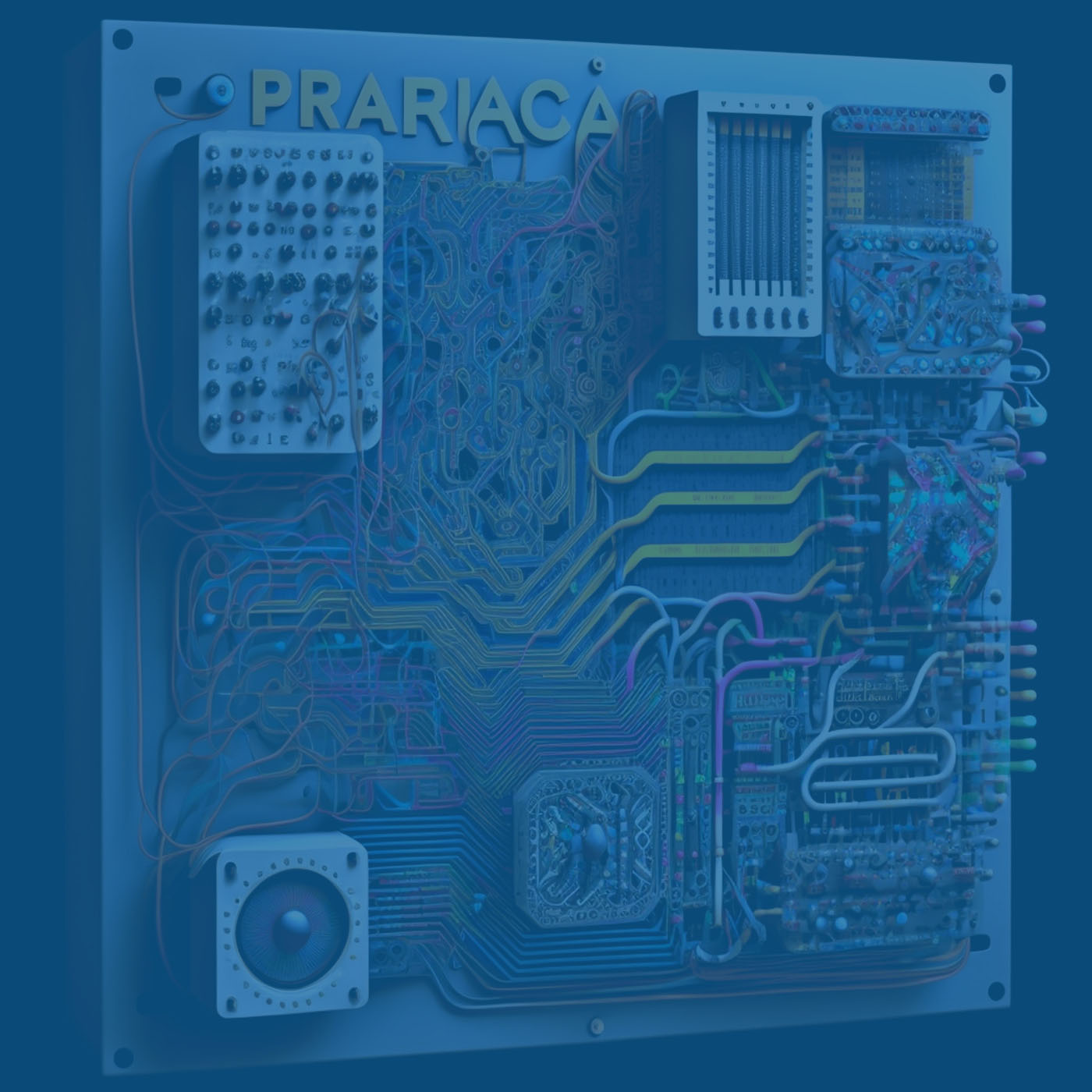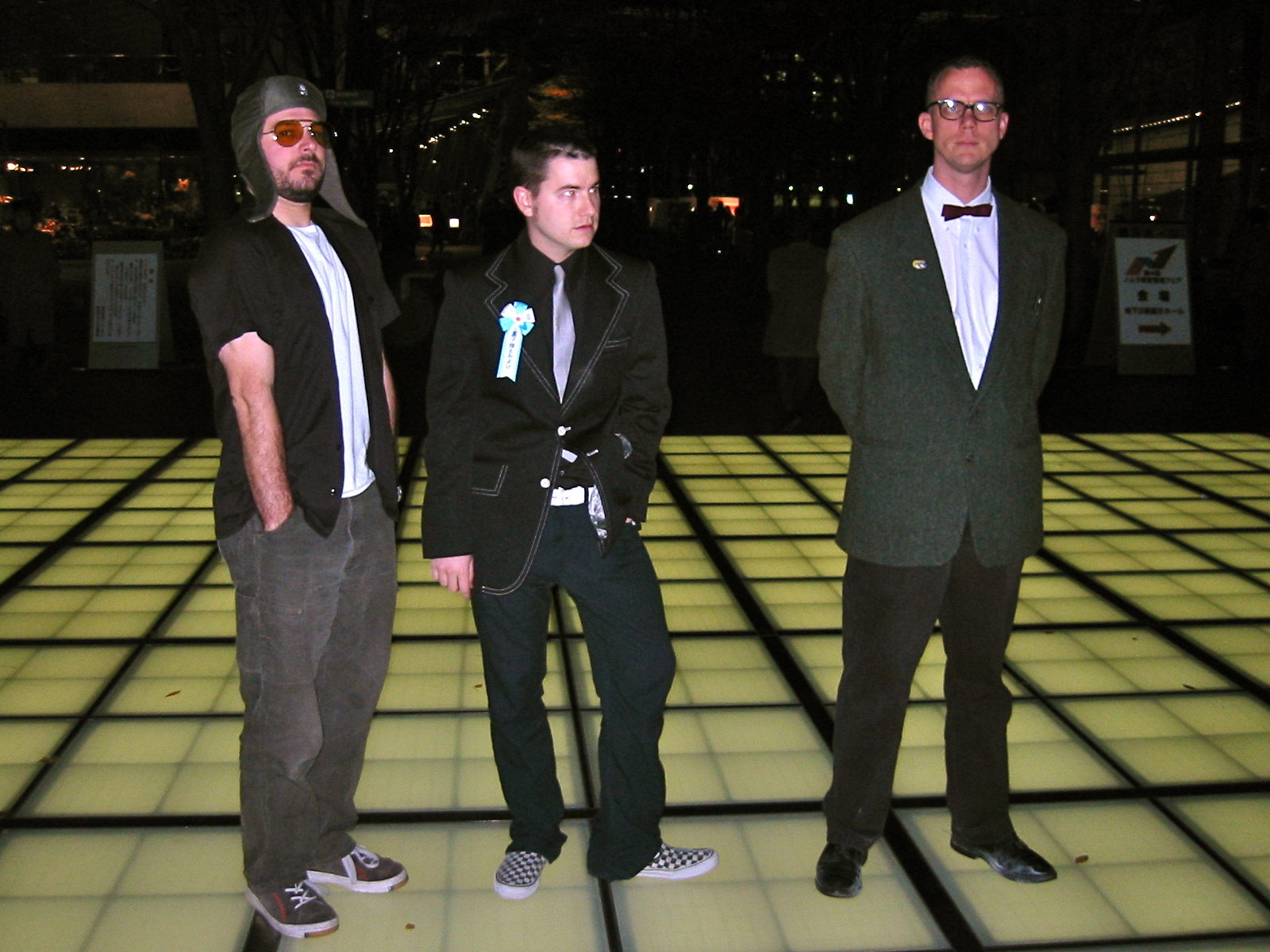
J Lesser is the stage name for Jason Doerck.
Born and raised around California, Doerck began his music career listening to and playing bass guitar black metal and punk.
An interest in electronic music drove Doerck to begin work with record label Vinyl Communications in 1992, adding more electronic flavor to what was otherwise a punk record label. Doerck settled in the San Francisco Bay Area in 1994, where he participated in the drum & bass scene. In 1997, he helped form the group Disc with Kid606, M.C. Schmidt and Drew Daniel (of Matmos). He also played with members of Crash Worship, toured with A Minor Forest, and later published a number of records on the label Tigerbeat6.
Between 2003 and 2006 Doerck was a member of the defunct laptop group Sagan, alongside Blevin Blectum, Wobbly, and video artist Ryan Junell.
In 2001, Doerck became a live/touring member of Matmos when they toured as an opening act with Björk in addition to playing as supporting musicians in her band on the Vespertine tour.
During the same year, his album Gearhound won an Honorable Mention for Digital Musics in the Prix Ars Electronica.
You started playing Electronic music in the early nineties, playing an important role in the San Francisco scene, teaming up with Blevin Blectum, Wobbly, Kid606, M.C. Schmidt and Drew Daniel of Matmos. How was it back then, can you share good anecdote, great memories?
Well, I met the Matmos thru Miguel (Depedro – Kid606). He went on an email campaign, contacting just about every electronic musician he could find an address for. He came up to San Francisco for a visit and was staying at my place. He invited the Matmos’ over and we all just shot the shit for hours. Martin (M.C. Schmidt) and I bonded over how inappropriate the Arby’s logo was… at least, that’s my memory – your mileage may vary.
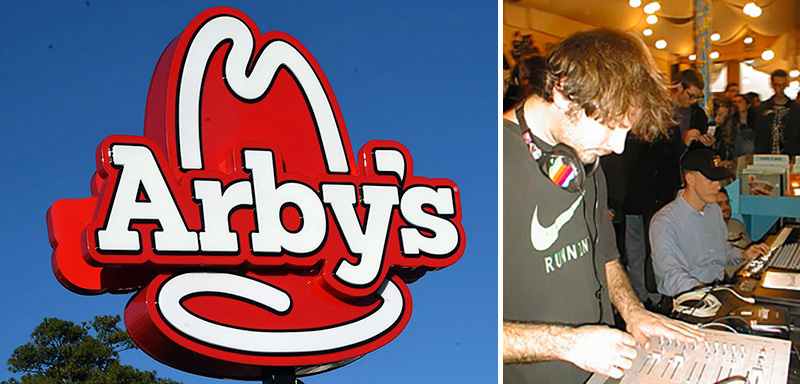
Miguel I’d met thru the Vinyl Communications label in San Diego, which was historically a punk label, but had transformed into, I guess, an industrial label? Anyway, Miguel was involved with a band called Spacewürm and was hanging about and working with Bob Bereley, who ran the label, to push it in a more electronic direction.
It was a couple years later that I met Wobbly at Aquarius Records. I was good friends with Andee Connors, then owner of Aquarius, (then owner of Aquarius & member of A Minor Forest, now member of My Heart, an Inverted Flame – Modular/Black Metal band). I was inviting the staff to a White Elephant holiday party at my place, and Wobbly asked if he could come as well. I didn’t know him really, or much of his work, but I’m not one to stand on ceremony… I said, “of course”. We’ve been friends and long-time collaborators ever since.
By the time Miguel had moved to San Francisco, his star was already rising. The Tigerbeat6 label brought a lot of artists together in one place. One of these was a show with Blectum From Blechdom, not sure if I was there playing as part of Matmos or as Lesser… but I think Wobbly played too? I dunno. In any case, that’s where I met Blevin. We got on really well musically, and I fell in love. We had a good run at our relationship, lots of collaboration, including the band Sagan, with Wobbly and Ryan Junell.
I consider myself to be so incredibly lucky to be in the right place at the right time. I’ve ridden on a lot of coattails in my time.
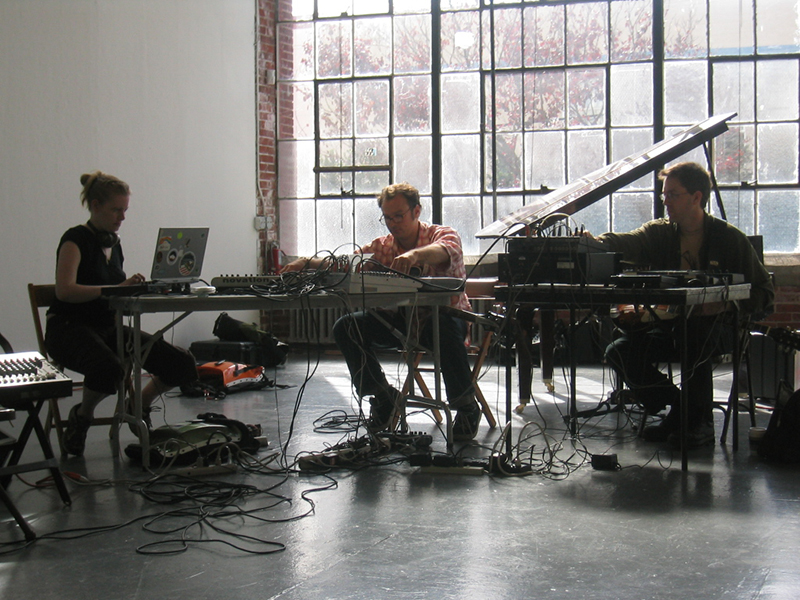
Would you like to retrace your career, maybe telling a little about the album of yours which paved the way and were crucial in your development?
I started out playing bass in hard rock/metal bands – concentrating my bass playing on being more of an extension of the drums. Once I saw how the recording process looked, I got more interested in that side of things… Trying, and failing, to record all the parts of a song myself which led to drum machines, MIDI, synths/sync, etc. I recorded a couple albums-ish that were more songwriter-y — like Ween or Bongwater or Butthole Surfers – weird but still songs. Then some material that was closer to industrial music – working in Pro Tools. After that, I guess I devolved into a Plug (Luke Vibert) wannabe and tried, unsuccessfully over the course of a couple releases, to be drum-n-bass adjacent. That’s the material that got me on the map. Excommunicate the Cult of the Live Band and Welcome to the American Experience.
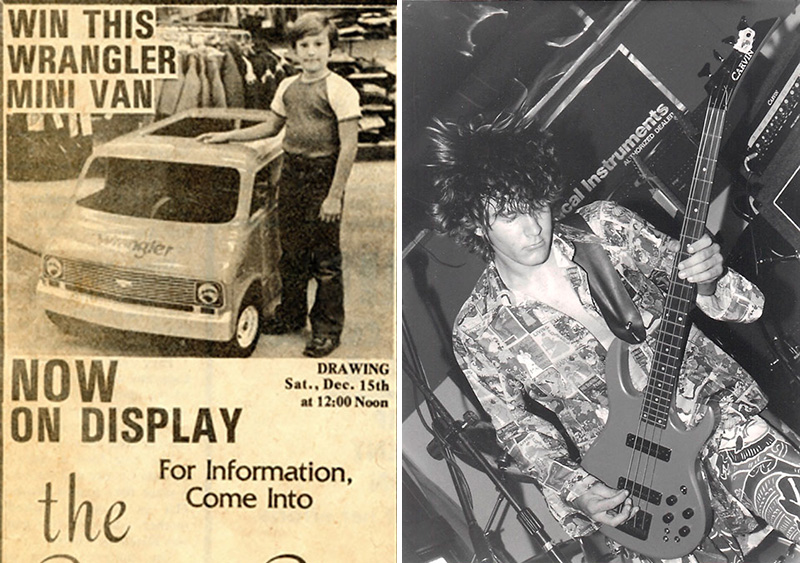
But I don’t think it was until putting together the material for Gearhound that I felt I’d turned a corner. This was just before and during the time I met Blevin. Not concentrating on songs, per se, but compositions – such as they were. I’d always been interested in recording sounds that weren’t particularly suited for music or combining such sounds in ways that shouldn’t complement each other. It wasn’t until this point that I gave up even trying to make songs that were, eh, palatable? Lesser was never particularly palatable, but at least the music was organized into something sort of like songs… that had parts. Beginning, middle, end… sorta kinda. The songs on Gearhound are hyper-composed. Obsessively composed, but not into songs, I think.
What have you been working on lately, and do you have any upcoming releases or performances?
I’m an old dad and my eyes get tired at night after work. Really tho, I went for a long time without recording or thinking about releasing anything. I spend most of my free time with the family – music and recording, for me, is a very solitary practice, so it’s hard for me to justify time spent on it. Lately, tho, I’ve moved the modular system into my office, where, when I need time to clear my head, I can walk over and patch a couple cables, turn some knobs, and see how that sounds in another hour.
Its very relaxing.
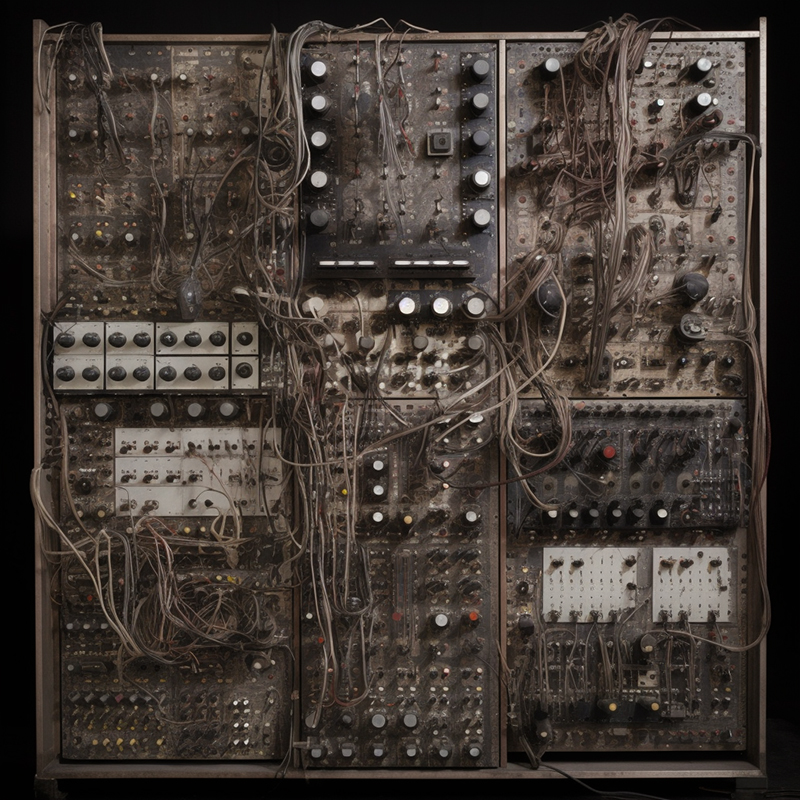
How were you first acquainted to Modular Synthesis? When did that happen and what did you think of it at the time?
How does it marry with your other « compositional tricks »?
Like Thomas Dimuzio, my first synth was a second (third/fourth?) hand Sequential Circuits Pro-One. That had audio and cv/gate in. Its not modular by a long shot, but it has super flexible internal routing. It was the first synth I really learned how to use and I still think about it fondly – I’ve been tempted to buy the Behringer knock off, but have resisted.
Long after that synth, in 2002 Dave Smith, from Sequential, released the Evolver. Just like the Pro-One, the routing matrix is a thing of beauty. That was probably the first time I ever considered getting into modular synthesis. The options were… still are… endless on that machine. Again, I still love it – would never consider getting rid of it.
I think the fact that everything in a modular system is both audio (sound) and control voltage (composition). It’s never just one or the other – the best patches are both. I used to spend a lot of time tweaking/misusing the parameters of 3rd hand, mass release synths from Kawai or Yamaha to get them to places that no longer sounded ‘synthy’ to me… Not sounds usable for any purpose other than just being on their own. Because of the flexibility of a modular system, you can ‘misuse’ any module without voiding the warranty.
Your compositional process is also based upon the use of acoustic instruments that you process or combine with Electronic. How do you work to marry that Electronic with your acoustic matiere?
You know, I haven’t played any instruments in a recording context in a long time, tho I’ve been spending a lot of time with a ukulele… Its not the first instrument you’d think to associate with angular electronics. That said, since putting more time into music again, some of these modular excursions could be complimented with traditional instruments – being a one person band, the opportunity is there to set up a patch and improvise as with another performer… albeit a somewhat chaotic and irrational player…
I actually experiment with the other side of the coin. Re-recording fully electronic sounds in a physical environment. I mess around a lot with running sounds thru different speakers and re-recording them. A neat trick to pick up ambiences is to get a rechargeable Bluetooth speaker and play modular recordings thru it – recording the ambience with a field recorder like the Zoom H2n. I try to get recordings out in nature and around Philadelphia. Placing the sounds in an unfamiliar soundstage rather than just playing field recordings along with your modular set…
When did you buy your first system?
Honestly, my first modular system was Native Instrument’s Reaktor. Pretty sure I bought that in 1996. I didn’t have a lot of cash so any hardware systems were out of my reach, and I hadn’t considered building my own components. Reaktor was a beautiful thing, and powerful. Being able to design your own synths from the basic bits up to, later on, customizing the interfaces… and do it with samples as well as oscillators… sheesh.
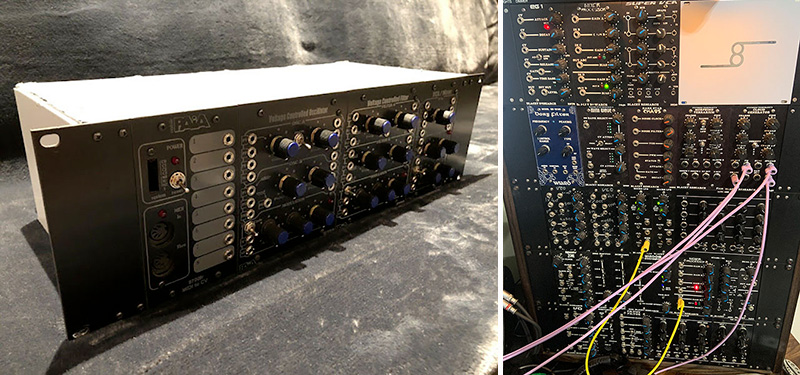
What was your first module or system?
How long did it take for you to become accustomed to patching your own synthesizer together out of its component parts?
I built a Paia 9700 series in the early 00’s, starting with the oscillator. So I spent like a month with just the oscillator with a volume pedal between it and the mixing board as I didn’t have a good way to step the volume down… Probably should have built something, but I wasn’t that bright. I could take CV from the Pro-One to control the pitch, but the obvious choice was to plug every output into an input and see what a mess I could make.
A little later I started building Blacet Frac modules to compliment the Paia. They were significantly more complicated in the soldering department… After ruining a few with my sausage fingers and failing eyesight I decided I shouldn’t build anymore… I was tired of the magic smoke. I filled 5 19″ Frac racks over time. That’s the modular I would bring on tour with Matmos. Most of those modules have survived being lugged around the globe. I could look at trying to replace them with Eurorack format, but I’m an emotional sort.
It’s interesting that you mention how long it took to become accustomed to patching. I think the original patching made sense to me, owing to having had the Pro-One and knowing what was available for modulation. I think it’s actually been harder to decouple patches from the obvious, tried-and-true practices. OSC -> FILTER -> VCA -> EFX. That was hardwired into my practices with EVERY generic (heck, even original) synth that was available on the market. So many of my early patches, while more interesting than something that I could have created on a standard synthesizer, still followed that very EAST COAST format. Embarrassingly the top row of my Mantis case is basically OSC->FILTER->VCA->EFX…
What was the effect of that discovery on your compositional process?
On your existence?
Ha! Well, for me it was quite liberating. I’m an application developer most of my waking hours so building logical systems comes naturally. While controlling a synth with MIDI is obviously very powerful, it is basically just a piano roll. Ya, you can add some modulation… and yes, there are powerful MIDI generation tools… NOW… But being able to create a feedback loop of control voltages that can vary greatly over time, even modulating between movements – ambient into rhythmic into noise into ?
Plus the tactile nature of these modules over working in the computer is visceral.
I will never look down on software systems, they are on paper and to the ear as good as the modules. But as I’ve said earlier, I’m old now and I don’t like to look at computers outside of work any more than is absolutely necessary. 🙂
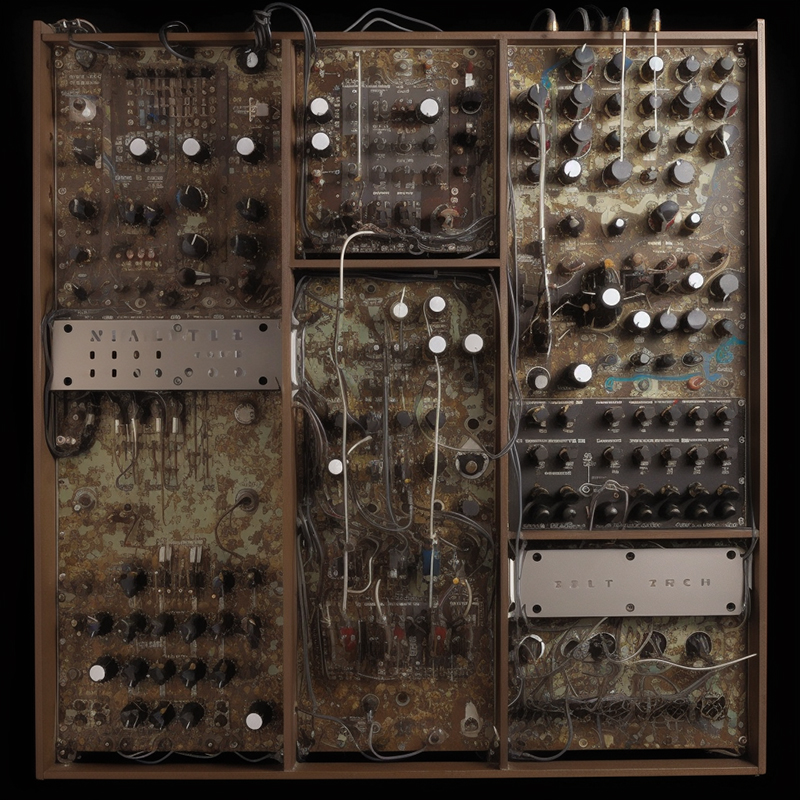
Quite often modularists are in need for more, their hunger for new modules is never satisfied? You owning an impressive amount of gear, how do you explain that?
Some people collect records. Some people collect coins. Some people collect watches. At least my collection gets used nearly every day.
A well designed module can make you rethink your entire compositional framework – even if that wasn’t the creator’s intention. And I don’t just mean boutique modules with esoteric markings.
Do you prefer single-maker systems, knowing your love for BugBrand or Metasonix, or making your own modular synthesizer out of individual components from whatever manufacturer that match your needs?
Generally I’ve stayed away from single-maker systems as they tend to be opinionated about the type of composition/sonic palette you can expect to work with. Sure, its all just electronics and you can get results from any system, but it may take more work. Aesthetically, yes. I mean, damn, a full rack of Bugbrand or a Buchla system is beautiful: each one a work of art and my own rack is an ugly mess of colors and styles… But its my ugly mess.
Each module is a piece of technology I’ve chosen to perform a purpose, in that respect working with a single-maker system is an interesting composition challenge.
Aesthetically, I get the appeal. Those systems, while they are not limiting in any way, have pretty opinionated ways of working and they are, absolutely, instruments, in the classic sense.
As I generally grow one module at a time, I can learn what my system is capable of and where it needs support. I can imagine that even if I was wanting to work with a single-maker system, I’d want modules to perform functions that aren’t there… Do I want to be “limited” by the instrument or do I want to do my own thing? I don’t have an answer. If anyone has a Serge to spare, I can craft a better response 🙂
If anyone has a spare Buchla or Serge sitting around, feel free to ship it to me and I’ll let you know how it goes…
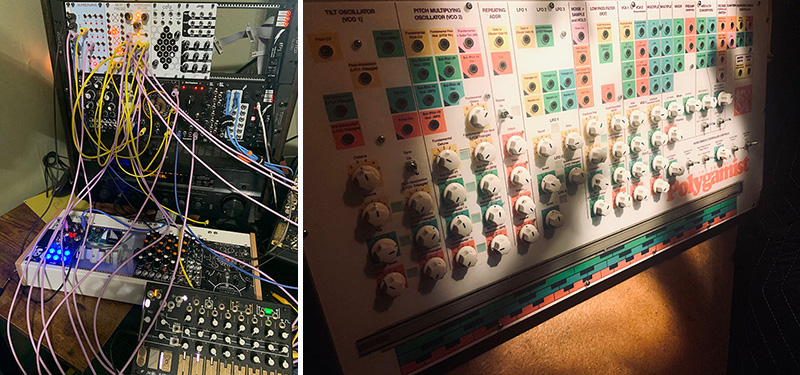
How has your system been evolving?
I stayed with my Frac rack and an Ekdahl Polygamist for many years. As a team they served me well. I recorded Elder Bits around 2010 with those. It wasn’t until I think 2020 that my friend Jason Soares from Aspects of Physics and Points of Action: Quadra got me interested in Eurorack. He’s based in San Diego (I’m in Philadelphia) and he wanted to collaborate on synthesized music in quad – live streaming of both audio and CV. The only way to do that was with the internet and a D/C coupled audio interface – the ES-9 was a perfect choice. Since then the Eurorack side of the family has grown a little at a time.
Lately I’ve started looking into modules from Nonlinearcircuits and Error Instruments. I love the NLC stuff because, to me, it aesthetically harkens back to Ken Stone’s work with the Cat Girl Synth and I love his take on composing chaos. The Error Instrument modules are definitely more self-contained… they do “a thing” – whether you do or don’t like that thing is another story. I happen to like the things they do… and again, the aesthetics are there in the design.
Instrument building may actually be quite compositional, defining your sonic palette, each new module enriching your vocabulary. Would you say that their choice and the way you build your systems can be an integral part of your compositional process? Or is this the other way round and you go after a new module because you want to be able to sound-design some of your ideas?
The way you phrase your question is quite interesting to me… Do I think of my modular as an instrument? Not really. When you build single-maker systems it can feel that way and the design/UI supports that feeling. When I think about adding to my modular I tend to think in terms of what modules are most flexible, which have the most varied functionality, the most sonically diverse. I really don’t want my system to sound or act the same every time I patch it. In that respect it is an instrument building system.
Do you tend to use pure modular systems, or do you bring in outside effect and devices when playing or recording?
For the last 10 years its basically all just been modular work. I have a few distortion boxes, some of the Korg Volca Line, and an Ekdahl Moisturizer for spring reverb; otherwise most effects are in Ableton Live.
Would you please describe the system you used to create the music for us?
Can you outline how you patched and performed your Modulisme session?
Soooo… these tracks come from very different times, modules, and patches, but I can go thru them and try and remember what was going on.
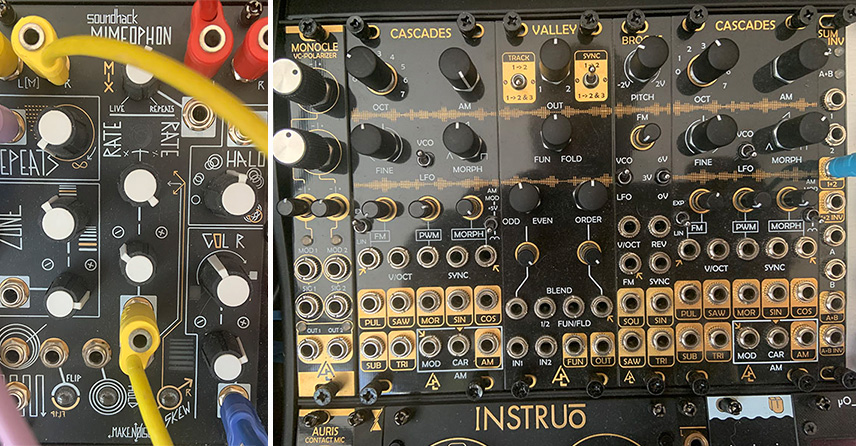
The Last Grain of Ynyr: First off, this is Mimeophon handling everything that sounds like grain synthesis and reverb. Definitely a Krell patch timed by Maths and the main oscillators are the dual Blacets. One of them is run thru a bass amp, which gives it a really dirty, overdriven sound. DIstorted filtering is the Wiard Borg, clean is the Behringer Multimode Filter/Resonator Module 1047 clone… that combo figures pretty heavily throughout these tracks.
National Bring-a-Juggalo-to-Work Day: Main trebbly oscillator is the After Later COCO (Cascades). Seems like the rhythm is sequenced on the 0-CTRL with clock from Tempi – probably being changed up with Pressure Points. The “melody” must be the Music Thing Modular Turing Machine, but I’m surprised I let it run without screwing it up for so long.
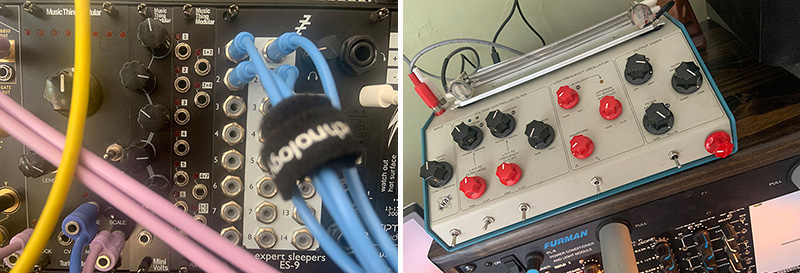
Sloppy Moisturizer: For sure, the main oscillating buzz and all reverb is coming from the moisturizer – modulated by the onboard LFO – into audio rates near the end of the track. I’d be tempted to say the rubbery bass sound is coming from Pixie (a clone of the Mutable Instruments Plaits), but this was recorded before I got that so it must be COCO again. Random electronic noises are coming from the Tele Blender from Error Instruments. The mid-range tremolo synth is actually the Arturia MicroFreak. No idea where that weird sort-of minimal techno chord is coming from :).
Lesser (circa 1957): This is all from the Korg Volca Modular. Highly recommended as anyone’s initial foray into modular synthesis – $100… can’t go wrong.
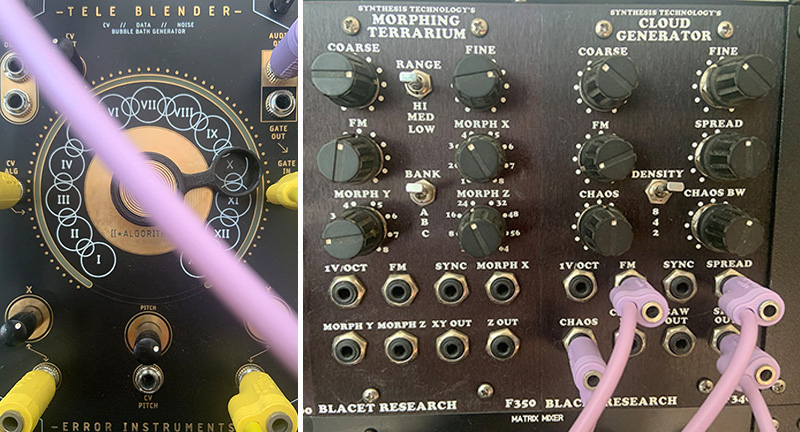
Sunset Shredder Boogie: VCV Rack Supercell module; software clone of the Grayscale clone of Mutable Instruments Clouds. Pretty sure I was feeding it a very banal oscillator sequence.
Generans Murmura Soporifica: This is the F-340 Cloud Generator from Synthesis Technology, specifically the Frac version. Such a lovely module. It can do that really huge Roland supersaw sound and it can do… this… The recording really hearkens back to Darkest Before Dawn by Steve Roach… an hour of face melting ambience… I kind of think of it as the soundtrack to the heat death of the universe. Not sure what he had in his rack, but the Cloud Generator module was based on the work of Robert Rich. Were they buds?
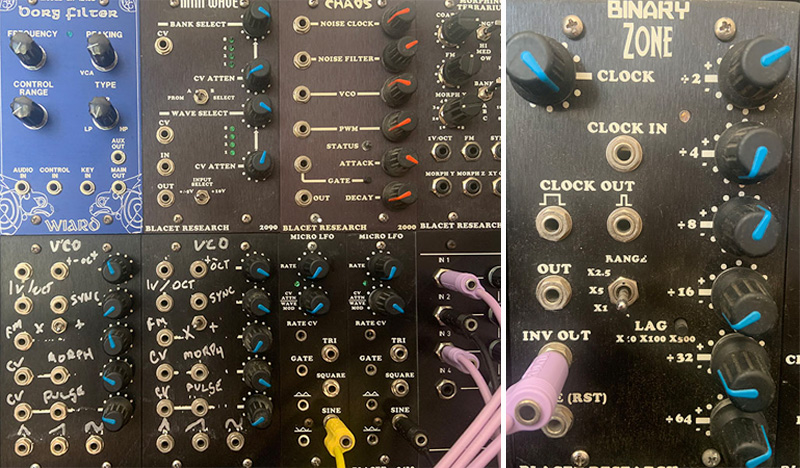
Thumpin’ Heads, Esq.: More Tele Blender here… so great for finding grating ambiences… as well as bursting for percussion. Kicks and hats from Blacet VCOs and the Dark Star Chaos. Pitch sequences are being generated by the Blacet Binary Zone into COCO. Decided to invest in the SSF Ultra Kick after recording this… I love the way these kicks sound, but I wanted something that was slightly easier to control.
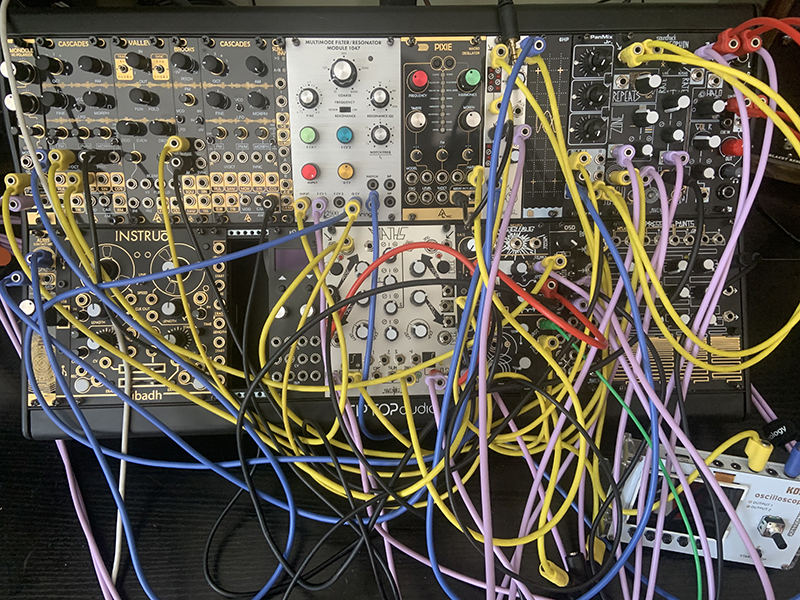
Iv’s Irresonant Flux: This patch I worked on with my kid, Iv – explaining the idea that everything in a modular system is both audio and control. Here are the notes I made for Iv for future reference:
Ok, so… Audio is green, white is CV modules, control is purple, and clock (bpm) is blue.
VCOs 1-3 are making all the weird sounds and Voice (Pixie) is making anything that is vaguely violin analogous. The VCOs go thru a low pass filter that cuts off the higher frequencies of the sound. VCAs control the relative volume of the audio. All that goes thru Mimeophon.
The brains of the patch is Maths, which creates control voltages that evolve over time, basically computing the time it take to change a voltage from effectively 0 to maximum and back. Channel 1 is triggered to start at a certain time, while channel 2 is cycling endlessly. Note: there is a feedback loop from Channel 2 into Channel 1, which causes the Rise/Fall time of Channel 1 to change depending on where Channel 2 is in its cycle. These envelopes are running very slowly.
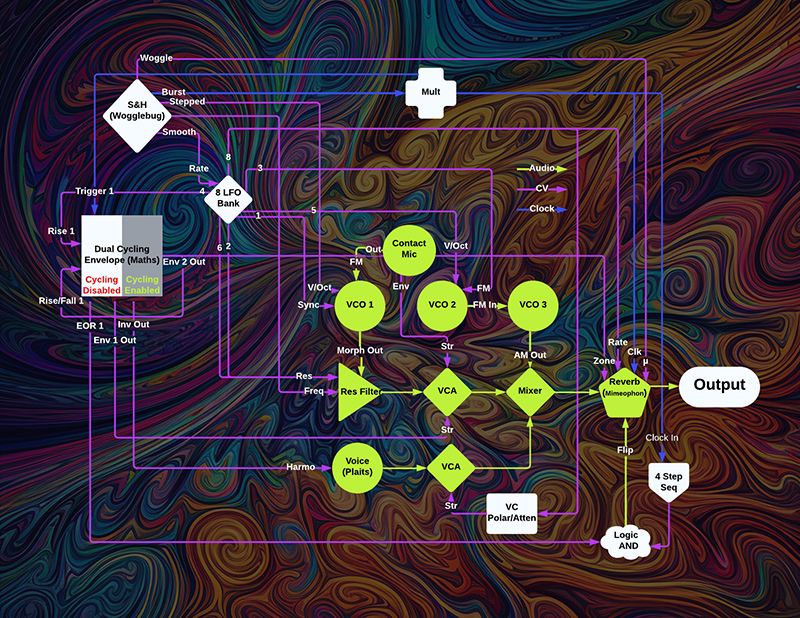
Meanwhile, the Wogglebug creates continuous streams of random triggers and voltage while the 8 LFO bank, cycling at glacial speeds, modulates parameters across the patch.
The only human interaction with the patch is a contact mic that can be spoken into or scratched/hit to frequency modulate the pitch of VCO 1 and the relative volume of the filter.
Note: Thank you Aaron Taylor-Waldman for your excellent Krell layout, of which I have created a poor facsimile.Crisp Evergride: This is more of a mystery… Obviously there’s Mimeophon, oscillator sounds like COCO to me, but I could be wrong. I think everything is going thru the Metalbox Tube VCA to crunch it up.
Prariaca: The main oscillator is actually the Mimeophon self-oscillating. Original sequence is being generated and quantized by Ornament & Crime, running Benisphere – I haven’t mentioned O_c before, but it is such a workhorse… its doing something in nearly every patch but it doesn’t normally sit center stage.. We’re getting weird filtered reverb from the Moisturizer, I have no idea how its getting randomly plucked, but damn thats a mean sound. Soundstage reverb from Ableton Live in post.
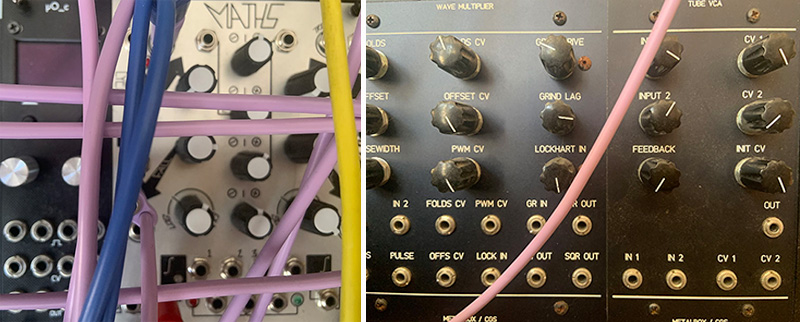
Do you find that you record straight with no overdubbing, or do you end up multi-tracking and editing tracks in post-production?
Again, for the last 10 years or so, I haven’t done any tracking or serious sequencing on the computer – one pass modular recordings. That said, I’ve recorded some modular passes that are begging for more composition and layers… I’m hoping to get started working on those tracks soon.
Do you pre-patch your system when playing live, or do you tend to improvise on the spot?
I haven’t played live in a long time, but I never pre-patched… The terror of empty patches and an audience is just too good. I played a few shows with just a deck of cards that I had very general patching ideas taped to each card. To start the show, I was allowed to plug the main out into the mixer, draw a card, and make an initial patch. After that, it was one patch a minute for 40 minutes. A high wire act with a lot of silence, buzzing, and clicking – but worth it towards the end… I learned about the Patch card game a couple years ago, which gives you premade cards with much better instructions 🙂 Well worth a look.
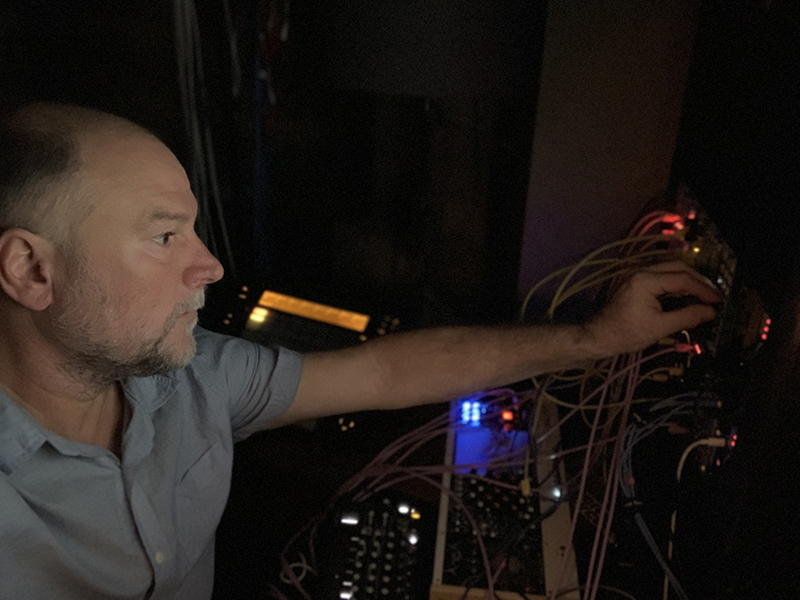
Which module could you not do without, or which module do you use the most in every patch?
Oof. That is difficult. I think I’d have to go with Mimeophon. It just has so much character. I’ve even used it with basically no delay or reverb as glue for sounds… It just has something… I don’t know. Tom Erbe is a genius.
Secondly, I think I’d give Honorable Mention to the Behringer 1047 clone. I’ve been a fan of the sound of the Arp 2500 filter for a long time, notably on recordings by Jack Dangers/Meat Beat Manifesto. Politically, I should splurge on the Instruō I-ō47, and I probably will at some point. I can’t put my finger on what makes it sound so good. Its just perfect to me.
What do you think that can only be achieved by modular synthesis that other forms of electronic music cannot or makes harder to do?
I guess that, again, my system is not an instrument, its a tool to make instruments. When I start unpatched I’m not forced into any particular tuning or rhythmic systems. Not locked to any clock. You aren’t led into any style of music. There’s no super cool sounding presets to be overwhelmed or annoyed by. Its just what I happen to build at the time. Sometimes its drones; sometimes beats… sometimes a completely unlistenable non-mix of both – even to folks that come to this website to listen to ‘unlistenable’ music. But that’s the joy of it.
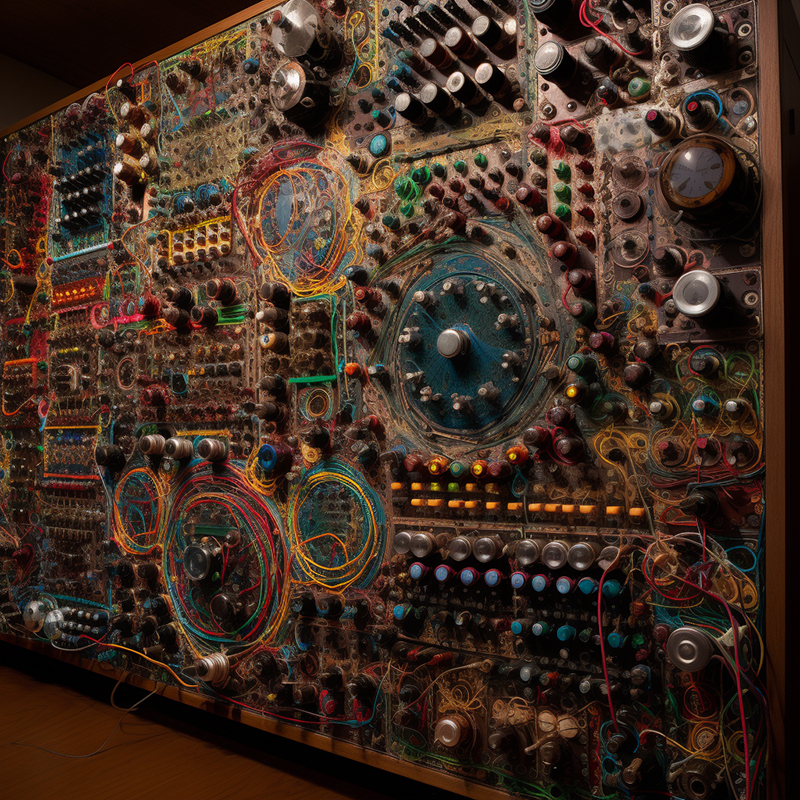
Have you used various forms of software modular (eg Reaktor Blocks, Softube Modular, VCVRack) or digital hardware with modular software editors (eg Nord Modular, Axoloti, Organelle), and if so what do you think of them?
I’ve mentioned Reaktor before, but I haven’t looked at it in ages, it seemed like it was abandoning the paradigm of build your own to support a growing population that just wanted to build a slightly different version of a Mini-Moog.
I love VCV Rack, and use it with my modular system frequently, more so since I got the ES-9 to behave all the time. Honestly, if I was not an old man (again with the tired and the failing eyes) I’d probably use it way more than the modular. You aren’t restricted to the modules you physically own, and investing in the software is super affordable. There are some cases where the physical unit has a slightly better sound.. But barely, especially after its mixed with other sounds… The only drawback is the UI of the units. The choices that module creators make for knobs, buttons, switches and layout… you just can’t get that physical connection with general midi interface controls – at least not the ones I have access to.
What would be the system you are dreaming of?
Honestly, its this system. As I said earlier, I’m investing in Nonlinearcircuits stuff, and I’d like to invest in some custom built CMOS stuff for sequencing… I’d been wanting something like Sugar Bytes’ Nest for a long time. While I am very grateful for the software version, something with actual knobs would be keen, but I ain’t going to solder it.
Are you feeling close to some other contemporary Modularists?
Which ones?
You know, its absolutely humbling to listen to the sets other artists have released thru your Modulisme platform.
To be honest, I live and work in a cave and don’t listen to much other than old ZZ TOP records. That said, as far as influencers go, I’d namecheck Omri Cohen and Cinematic Laboratory. Always happy to hear about new recordings from Thomas DiMuzio, Keith Fullerton Whitman, and Jack Dangers.
Thru Modulisme, I’ve also found kindred spirits Jos Smolders, MIchael J Schumacher, and Rodent.
Which pioneers in Modularism influenced you and why?
I don’t think that he had a whole lot of influence on my output, but I’d have to go with Morton Subotnick’s “Silver Apples of the Moon” because its just the perfect package. Trippy cover, loads to find at thrift stores and my utter disbelief as a 15 year old that this was something someone put on a record at some time in the 60s… and it ended up here, in sunny San Diego. It doesn’t get any better than that.
Any advice you could share for those willing to start or develop their “Modulisme”?
Everything is both audio and control.

